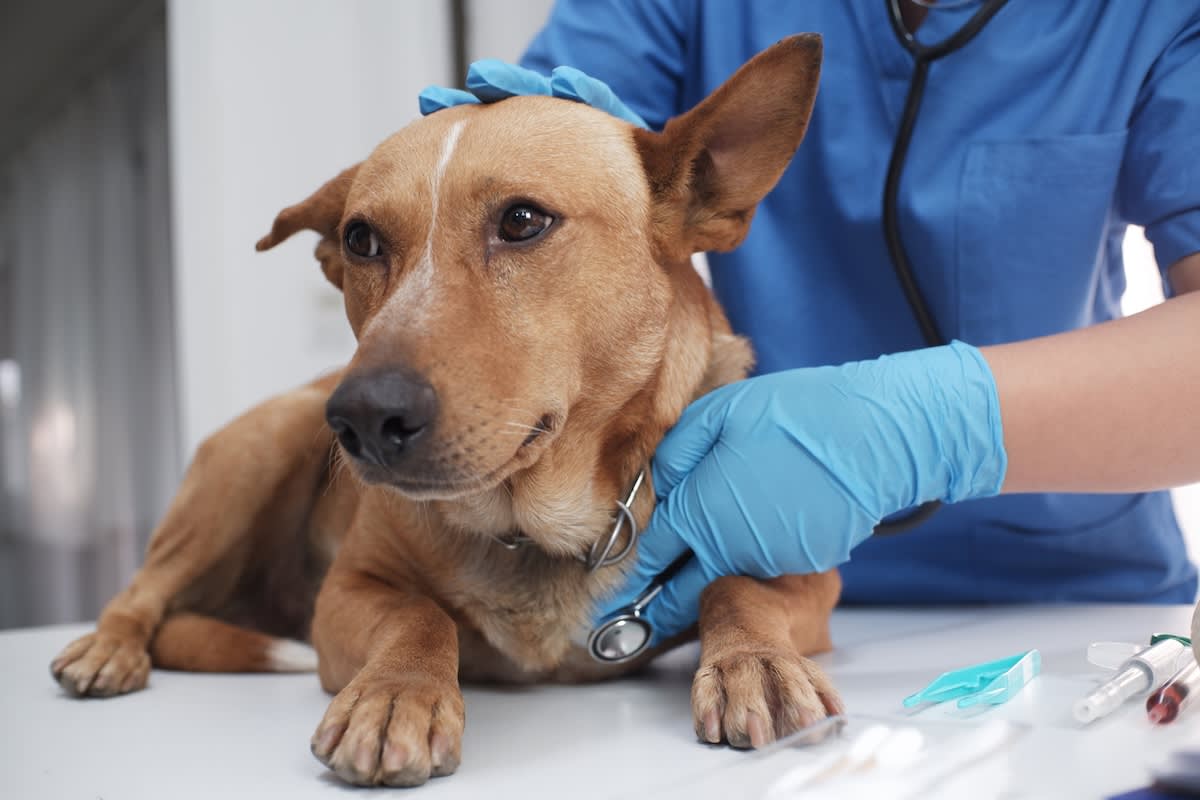How to Spot Brucella Canis in Dogs

Share Article
Most dog parents worry about fleas, ticks or the odd upset tummy when it comes to our pups – but there’s another, lesser-known health risk in the UK: Brucella canis. If your dog is carrying this bacteria, it’s important to know that it’s not just tricky to spot, it can also spread to humans. Here’s what you need to know to keep your pup (and yourself) safe.
What is Brucella canis?
Brucella canis is a type of bacteria that causes the disease brucellosis. It mainly affects domestic dogs but can also infect wild canine species such as foxes. It is a zoonotic disease, meaning it can spread from animals to humans.
Is Brucella canis common in the UK?
Brucella canis was first identified in the UK in 2002. Since then, the number of diagnosed cases has increased. It is not yet considered widespread in the UK; most infected dogs have been imported from eastern Europe or are the offspring of imported dogs. However, as the number of cases rises, experts are concerned that if left unchecked it could become established on our shores.
Countries that have known cases of Brucella canis
Brucella canis is found worldwide and is common in parts of North and South America, eastern and central Europe, Asia and Africa. Increasing numbers of cases are now being reported in western Europe as international pet transport becomes more common.
How Brucella canis is transmitted in dogs
The infection is most often spread during mating, or through contact with infected vaginal discharge, semen and afterbirth. Puppies can catch it from their mother before birth or through her milk. It can also spread via infected blood and, less commonly, through faeces, urine, saliva or nasal discharge.
Brucella canis symptoms in dogs
Brucella canis mainly affects the reproductive system. In females, it can cause miscarriages or infection of the uterus. In males, it can cause swollen or painful testicles. The infection can also affect other parts of the body including the heart, eyes, brain and spine. Symptoms vary widely depending on which organs are affected but may include tiredness, swollen lymph nodes, lameness, fever and weight loss. The signs are often subtle, and the disease is rarely fatal. Many infected dogs show no outward signs at all but can still pass the infection to others. Dogs may remain infectious for years.
How Brucella canis is diagnosed
Diagnosing Brucella canis is difficult. The most reliable test involves trying to grow the bacteria from samples of blood, urine, semen or vaginal discharge, but this is often unsuccessful. For this reason, other blood tests are usually used. These tests can give false results, which makes diagnosis and screening challenging.
Treatment of Brucella canis
Treating Brucella canis is very difficult. Antibiotics do not usually clear the infection completely, which means relapses are common and antibiotic resistance can develop. For this reason, treatment is not generally recommended. Some dogs may remain infected and infectious for life.
However, research suggests that in certain cases the dog’s immune system can eventually clear the infection, usually within two to three years. Because it is not possible to predict which dogs will clear the disease and which will remain carriers, veterinary authorities in the UK generally treat all positive dogs as if they could stay infectious for life. Risk management options vary from strict isolation of the infected dog to, in some cases, euthanasia.
Can dogs die from Brucella canis?
Young puppies or severely unwell dogs can sometimes die from brucellosis, but most infected dogs live with the condition for years.
What to do if you dog has Brucella canis
Brucellosis is a reportable disease in the UK, which means that if your dog tests positive, the Department for Environment, Food & Rural Affairs must be informed. The government only enforces euthanasia if your dog poses a significant risk to public health. Otherwise, the decision is yours. It is important to talk to your vet so you fully understand the risks to your dog, other pets and your family, as well as the limits of testing and treatment.
If your dog has Brucella canis, it’s important to prevent the infection from spreading. Keep your dog away from other dogs and avoid letting them mate. Always wear gloves when handling bodily fluids such as blood, urine, saliva, semen, vaginal discharge or afterbirth, and clean any surfaces, bedding or toys thoroughly with disinfectant. Wash your hands carefully after touching your dog or anything it has used. Before introducing new dogs into your home, make sure they are tested and free from infection, and always follow your vet’s advice on ongoing care and hygiene.
Brucella canis prevention
Brucella canis is usually brought into the UK by dogs that have travelled from, or been imported from, countries where the disease is common. Dogs living closely with imported animals are also at higher risk. Screening tests are available, and at minimum, dogs that have been imported or have travelled abroad should be tested.
However, these tests are not perfect and may miss infections or give false results. Because of this, a single test may not be enough to be certain about a dog’s infection status. Dogs that have been imported from high-risk countries, or those living closely with imported animals, should ideally be tested multiple times over several weeks to reduce the chance of missing an infection. Even then, no test is perfect, so good hygiene, isolation of suspected dogs, and caution with breeding remain important preventive measures.
The simplest, most effective, way to reduce the risk is to avoid importing dogs from high-risk countries. Infected dogs should not be bred from and are best neutered to prevent further spread. Avoiding contact with infected bodily fluids, especially semen and vaginal discharge, is also important.
The bottom line: Brucella canis in dogs
Brucella canis is a bacterial infection that mainly affects dogs, especially those imported from countries where the disease is more common. Most dogs that carry it may not show obvious signs but can still pass it on to other dogs, and in rare cases, to humans. The infection is hard to detect and even harder to completely treat, so managing it usually involves testing, keeping infected dogs apart from others, and avoiding breeding from them. While the risk to the general UK population is low, staying informed, practising good hygiene when handling pets, and taking precautions with imported dogs are the best ways to protect both pets and people.
Frequently asked questions about Brucella canis
Can humans get Brucella canis?
Yes, in people, the disease brucellosis can cause flu-like symptoms including fever, tiredness, joint and muscle pain and general malaise. In some cases, the infection can become chronic, leading to longer-term fatigue and recurrent fever. Human brucellosis is treatable with antibiotics, but because the infection is uncommon, doctors may need to be specifically informed that Brucella canis is a possible cause.
What does Brucella canis do to dogs?
Brucella canis mainly affects a dog’s reproductive system, causing miscarriages in females and swollen, painful testicles in males. It can also impact other organs, sometimes leading to tiredness, lameness, fever or weight loss. Many dogs show no obvious signs but can still spread the infection, and some may remain carriers for years. While usually not fatal, the infection can occasionally be serious in puppies or very unwell dogs.
How is Brucella canis transmitted between dogs and humans?
Brucella canis can be transmitted from dogs to humans when people come into contact with infected bodily fluids, such as blood, urine, saliva, semen, vaginal discharge, or afterbirth. The risk is highest for people who handle these fluids directly, especially if they have cuts or broken skin. Infection in humans is rare but possible, so good hygiene and protective measures, such as wearing gloves, are important when caring for infected dogs.
References
Department for Environment, Food & Rural Affairs. Risk Assessment on the Likelihood of Spread of Brucella canis to Great Britainopens in new tab. GOV.UK, 2023. [Online].
Department of Agriculture, Environment and Rural Affairs. Brucella Canis Advice for Private Veterinary Practitioners.opens in new tab DAERA. [Online].
Lucero, Natalia E., et al. “Brucella canis: An Update on Research and Clinical Management.”opens in new tab PMC, PubMed Central, 2017.
UK Health Security Agency. Brucella canis: Information for the Public and Dog Ownersopens in new tab. GOV.UK. [Online].
UK Health Security Agency. Canine Brucellosis: Summary Information Sheet for Veterinary Staff.opens in new tab GOV.UK. [Online]
UK Health Security Agency. HAIRS Risk Assessment: Brucella canis.opens in new tab GOV.UK, 2023. [Online].
Zhang, Yanhua, et al. “Emerging and Reemerging Zoonotic Brucella canis Infections.”opens in new tab Emerging Microbes & Infections, Taylor & Francis Online, 2023.

Dr Josephine Corrick, BVMSci, BSc, MRCVS
Dr Josephine Corrick, BVMSci, BSc, MRCVS is a veterinary surgeon based in the south of Scotland where she has been since graduating from the University of Surrey. She enjoys working in general practice treating small animals. Her particular interests include diagnostic imaging and the treatment of wildlife.
Having found a passion for veterinary medicine after doing a degree in Equine Sports Science she still enjoys including horses in her life by spending time with her highland ponies. Alongside her clinical work, she helps run a smallholding caring for rare breed sheep and exploring the Scottish countryside with her young Cocker Spaniel.
Related articles
![a picture of a brown dog swimming in water with a stick in their mouth]()
Deadly Blue-Green Algae is On The Rise – How to Protect Your Dog
It can be fatal to your dog
![picture of a chihuahua in a coat looking up at the camera with two plastic water bowls in the background]()
Is it Safe to Let Your Dog Drink From Communal Water Bowls?
Cute idea, not so cute consequences
![monty don and his golden retriever ned]()
7 Flowers That Are Poisonous to Dogs
Got gardening fever? Avoid these plants
![Close-up of a Merle coated Greyhound dog laying in the lap of their pet parent on the bed]()
Alabama Rot: The Deadly Dog Disease Most Pet Parents Have Never Heard Of
Ninety percent of cases occur between November and May




